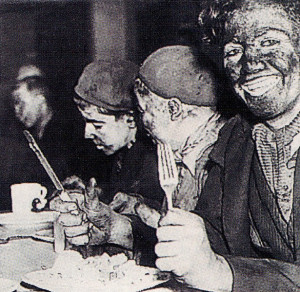
Anyone under 50 will not remember the Bevin Boys. These were the lads in the Second World War sent down the coal mines – almost the equivalent of the Victorian child chimney sweeps but ordered down rather than up.
My time in the pits began with a stroke of bad luck over my call-up number. The powers-that-be picked at random the last digit when selecting those to “go down” -and there was no option. Despite my appeal on genuine medical grounds, I was soon heading to Coventry on a Ministry of Labour rail warrant for ‘conversion’ from being a sixth form grammar schoolboy to a real miner.
A mixed bunch if ever there was, we all piled into a rickety old coach from our hostel to the training pit near Nuneaton. From my own point of view – and I suspect for many others in this motley crew – little was learned about mining. Morning lectures in a spotless classroom and afternoon guided tours down below could not prepare anyone for the unimaginable existence to come. A trainee miner whom I befriended quickly regretted his transfer request from the RAF!
And so supposedly now a miner – but anything but – it was off to join the night-shift (10pm to 6am) at Hanley Deep Pit at Stoke-on-Trent.
The hostel where we were to live was a sprawling collection of single-storey prefabricated huts on waste ground miles from the colliery. It was hardly the Ritz but at least it was weather-proof and warm. We slept a dozen to a hut. After the home cooking most of us had been used to even in wartime, the food was almost inedible. I survived mainly on bread supplied by the hostel and marmalade sent – as a life-
saving gesture – from home at regular intervals. It had to keep me going for five shifts a week.
We were ruled over by a major, basically a kind-hearted soul but to a population of 18-year-olds, he was a formidable rather than fatherly figure.
At the colliery, the Bevin Boys were treated with a little disdainfully with understanding and a great deal of sympathy by the real miners. We were employed mainly on haulage, transporting coal from the loading head, near the coal face, to the bottom of the shaft. At times, we must have been more
of a liability than an asset.
We were made to vaguely look the part -helmet on, lamp swinging from the belt, huge boots plus coal-blackened face and clothing. That’s where the similarity with proper miners ended.
Three or four-tier cages took us down the shaft and I quickly joined in the fight for the top tier. The professionals chewed plugs of strong tobacco and spat out many times during the 3,000-feet journey downwards.
The airless smell down below lingers to this day and a mile walk for a six-footer through four-foot high tunnels was punishing. The genuine miners took it all in their stride.
I was exhausted before getting to work which mostly involved slowing down trucks of coal racing at 30mph down a steep incline. The knack, in the interest of personal safety, was to fling steel pins into the wheels of the trucks, two at a time. Misjudgement or a flick-back from the wheel could take your head off.
Toilets? No such refinement – just find a handy nook in the tunnel (preferably not one already used) and later ignore the stench.
All this was for £2.1s.6d per week provided the full five shifts were completed -and the hostel and bus fares took most of that!
This was not a life; it was an existence -but a vital part of what was known as the War Effort’. Our numbers may now be dwindling but many may have seen us marching along the Mall at last year’s VJ Day commemorations and heard us mentioned by Her Majesty the Queen and the Prime Minister in their speeches,
Ian Christie








